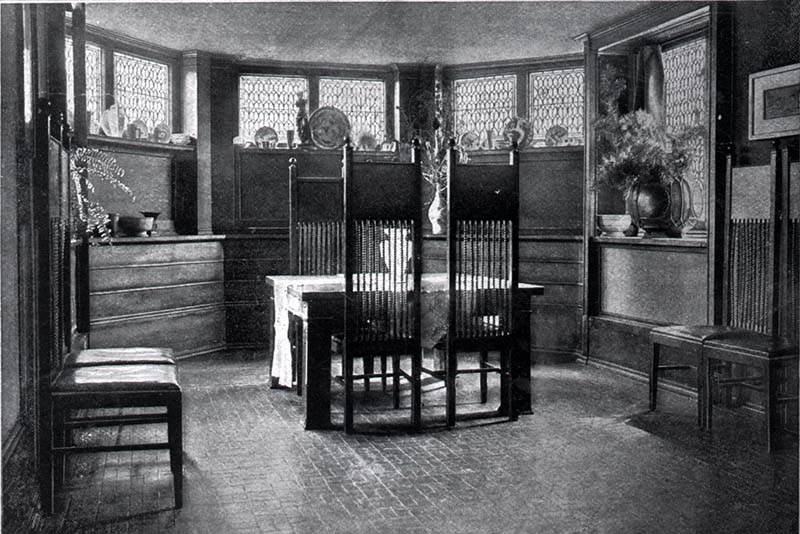Frank Lloyd Wright Furniture
Dining room furniture, Frank Lloyd Wright Home and Studio. Photograph by James Caulfield. Courtesy of the Frank Lloyd Wright Trust.
Dining suite furniture ca. 1899, Frank Lloyd Wright Home and Studio, Collection of the Frank Lloyd Wright Trust
Frank Lloyd Wright is one of America’s most influential architects and interior designers of our time. Believing that a home was more than a home by being a work of art, the designs of Wright interior furnishings were as influential as the exterior frameworks. Wright’s concept of organic architecture required that the interior sphere express freedom and tranquility as well. Wright stated that “the most truly satisfactory apartments are those in which most or all of the furniture is built in as part of the original scheme considering the whole as an integral unit.”[1] He did not trust the interior design capabilities of his clients to continue the fluidity and harmony of the home. Also, commercially produced furnishings were overelaborate and poorly constructed; therefore, not appropriate to be placed in clients’ homes.
One way to detour the issue of non-suitable furniture was for Wright to design and build furnishings that would complete and complement each individual home. The furniture was an extension of the home. Influenced by Japanese art and furniture, Wright created furniture that was simple, sophisticated, and subtle. Commonly based on a geometrical grid, his furniture added beauty and harmony to the homes.
There were two styles of furniture that Wright relied on to provide secondary space in his homes: built-ins and free standing. Built-ins became a prominent and common practice in Wright homes starting with his own house in Oak Park, Illinois, which was built in 1889. This concept was practiced up until his death in 1959. Built-in pieces varied from lamps, bookshelves, beds, benches, desks, and tables
Being moveable, Wright’s free standing furniture helped create a spatial flow and open space. Similar to built-ins, his moveable furniture was also built from organic materials. He believed that homes should influence and resemble family unity. One of the most important rooms to Wright was the dining room with a central table as a place for family time. Tall slated back chairs were a signature piece of Wright furniture, surrounding the dining table and protecting the family from the outside world. The dining table and chairs create a separate room within the eating area. Moveable furniture included: chairs, glass art lamps, tables, beds, and sofas.
For further readings and pictures of Frank Lloyd Wright furniture:
Frank Lloyd Wright: The Masterworks edited by David Larkin and Bruce Pfeiffer-1993.
The Decorative Designs of Frank Lloyd Wright by David Hanks-1979.
[1] David Hanks, The Decorative Designs of Frank Lloyd Wright (New York: Dover Publications, 1979), 27.



